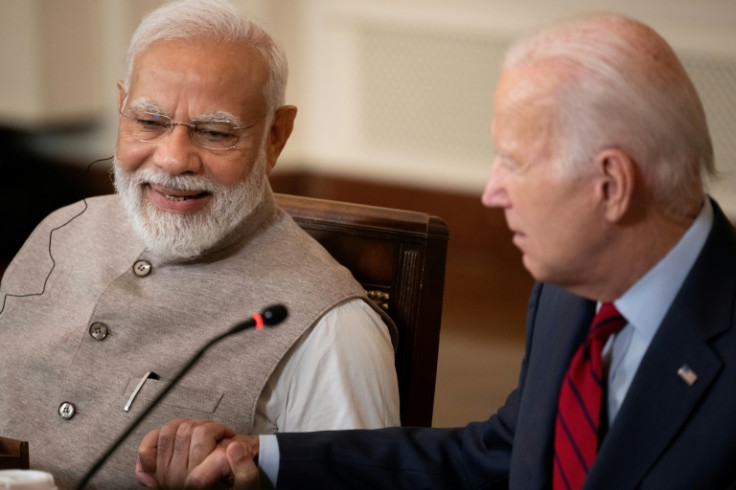Economic Corridor Unites US, EU, GCC, And India's 'Capabilities,' Could 'Rival' China's BRI

KEY POINTS
- Global leaders announced the development of the IMEEC on the sidelines of the G20 summit
- IMEEC will have the Eastern corridor connecting India to the Arabian Gulf and the Northern corridor connecting the Arabian Gulf to Europe
- The rail and ship network will also include ports, electricity cables, digital networks, clean hydrogen pipelines
Global leaders sang praises for the new India-Middle East-Europe Economic Corridor (IMEEC), which was announced on the sidelines of the G20 summit.
The U.S., India, Saudi Arabia, the United Arab Emirates, France, Germany, Italy and the European Union announced a Memorandum of Understanding to develop the IMEEC.
Described by global leaders as "historic," "game-changing" and a "landmark corridor," the project is aimed at improving connectivity between the three jigsaws of trade potential.
The network is poised to be the modern-day spice route, and will include railway and shipping links to create two corridors -- the Eastern corridor, connecting India to the Arabian Gulf, and the Northern corridor, connecting the Arabian Gulf to Europe. The network will also be studded with ports, electricity cables, digital networks and clean hydrogen pipelines.
"This is important for a basic reason, and that is the value of this trade corridor since historic times. The Gulf region has always been at the cross-section of trade between Asia and Europe, or more specifically, the Indian Ocean region and the Mediterranean Sea region," Md. Muddassir Quamar, author of "Education System in Saudi Arabia: Of Change and Reforms," told International Business Times.
"The idea of the proposed Corridor is to bring the capabilities of the US, EU, GCC, and India together to enhance infrastructure development and create greater regional connectivity in the Gulf and Middle East region, while also enhancing the capabilities in terms of the existing connectivity routes between India and Gulf and Gulf and Europe through Jordan, Israel and Egypt which can change the geo-economic landscape of these regions," he added.
For New Delhi, which has vigorously been attempting to solidify India's position in global supply chains, the new corridor could offer the country a significant advantage in the flow of trade from the region to the Middle East and Europe.
"If one looks at the current situation, both the GCC and European Union are among the biggest trading partners of India in the world. And, as the Indian economy continues to grow, including the manufacturing and exports sectors, the significance of this proposed Corridor enhances manifold," Quamar said.
As for countries in the Middle East, the project will aid the region's requirement of greening its economic activities. The new corridor could help the Middle East diversify its trade portfolio and eventually steer away from oil at a time when the world is becoming increasingly carbon-conscious.
"The GCC countries have been investing significantly in economic reforms and diversification to prepare for a post-oil economy. They are also preparing themselves for a greener future which means reduced dependency on hydrocarbons," Quamar said. "This is most importantly visible in the cases of Saudi Arabia and UAE. Saudi Arabia is key because of the size of its economy, its rapid transformation and the growth trajectory it has witnessed in recent years."
The creation of such an economic corridor is also seen as a counterweight to China's Belt and Road Initiative (BRI), which is Beijing's ambitious infrastructure project aimed at expanding the country's commercial footprint by connecting the mainland to Southeast Asia, South Asia, Central Asia, Russia and Europe.
"The IMEEC could very well rival BRI based on the fact that much of the infrastructure required for IMEEC is already in place. If policies that would bind the participating nations are aligned successfully, it could become a successful venture," Kabir Taneja, a Fellow with Strategic Studies programme at Observer Research Foundation, told IBT.
"While it is natural to look at it as a collaborative first step in the direction of countering the BRI, one could argue that the more immediate trigger has been China's growing presence in West Asia -- Saudi Arabia recently signed a USD 3.6 billion deal to supply Rongsheng Petrochemical, and Iran's crude oil exports to China have been reaching record heights," Bashir Ali Abbas, Research Associate with Council for Strategic and Defense Research, told IBT.
Quamar, who also agreed the new project could be viewed as an alternative to the BRI, believes such economic corridors "can co-exist with the economic logic proving to be the real difference in terms of which one succeeds or fizzles out or continue to co-exist."
Since trade routes connecting the concerned geographies already exist, the new economic corridor will not be just about moving freight, but also developing new supply chains, Taneja noted, adding the players involved in IMEEC should make sure the trade route "goes beyond just political upmanship."
"Policy needs to offer a good product to the market economics, considering the latter will ultimately decide whether this is feasible or not. History is littered with both, unfinished and often failed connectivity projects, including large chunks of the BRI itself," he added.
"The bottom line is that the IMEEC is a welcome decision, it can change the complexion of economic interaction between the three regions and boost their economic growth further, and finally can help in bringing the much-needed economic connectivity, and indirectly political stability," Quamar said.
© Copyright IBTimes 2024. All rights reserved.






















